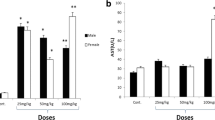Abstract
Ascorbic acid concentrations were determined in livers, spleens and kidneys of 27 white rats infected withFasciola hepatica and 15 controls. Tissue ascorbic acid levels were consistently lower in infected animals and this was associated with decreased liver total proteins and glycogen.
Similar content being viewed by others
References
Barnes MJ (1975) Functions of ascorbic acid in collagen metabolism. Ann NY Acad Sci 258:264–277
Charlton RW, Bothwell TH (1976) Iron, ascorbic acid and thalassemia. Birth Defects 12:63–79
Combs GF Jr, Pesti GM (1976) Influence of ascorbic acid on selenium nutrition in the chick. J Nutr 106:958–966
Denson KW, Bowers EF (1961) The determination of ascorbic acid in white blood cells. A comparison of WBC ascorbic acid and phenolic acid excretion of elderly patients. Clin Sci 21:157–162
Gameel AA (1982) Plasma ascorbic acid levels in sheep experimentally infected withFasciola hepatica. Z Parasitenkd 66:321–326
Gipp WF, Pond WG, Kallfelz FA, Tasker JB, Van Campen DR, Krook L, Visek WJ (1974) Effect of dietary copper, iron and ascorbic acid levels on haematology, blood and tissue copper, iron and zinc concentrations and64Cu and59Fe metabolism in young pigs. J Nutr 104:532–541
Hawkins CD, Morris RS (1978) Depression of productivity in sheep infected withFasciola hepatica. Vet Parasit 4:341–351
Kadziolka A (1962) Distribution of glycogen and vitamin C in the liver of cattle affected with parasitic cirrhosis (fascioliasis) (English summary). Med Wet (Warszawa) 18:93–99
Lowry OH, Rosenbrough NJ, Farr AL, Randall RJ (1951) Protein measurement with the Folin phenol reagent. J Biol Chem 193:265–275
Morris DL (1948) The quantitative determination of carbohydrates with Dreywood's anthrone reagent. Science 107:254–255
Subramanian N, Nandi BK, Majumder AK, Chatterjee IB (1973) Role of ascorbic acid on detoxification of histamine. Biochem Pharmacol 22:1671–1673
Turely SD, West CE, Horton BJ (1976) The role of ascorbic acid in the regulation of cholesterol metabolism and in the pathogenesis of atherosclerosis. Atherosclerosis 24:1–18
Wilson CWM (1974) Vitamins and drug metabolism with particular reference to vitamin C. Proc Nutr Soc 33:231–238
Ziolo T (1960) Distribution of cholesterol and vitamin C in the adrenal cortex of sheep with cirrhosis of the liver due to fascioliasis (English summary). Med Wet (Warszawa) 16:646–652
Author information
Authors and Affiliations
Rights and permissions
About this article
Cite this article
Gameel, A.A. Tissue ascorbic acid concentrations in rats experimentally infected withFasciola hepatica . Z. Parasitenkd. 68, 181–184 (1982). https://doi.org/10.1007/BF00935059
Accepted:
Issue Date:
DOI: https://doi.org/10.1007/BF00935059




